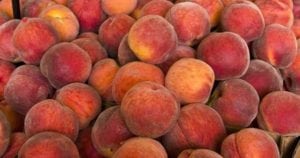Surprising Facts About Peaches

By Sarb Johl, Peach Grower
Chairman, California Cling Peach Board
There is nothing like the juicy, sweet flavor of a perfectly ripe peach, whether that peach is fresh or canned. And peaches not only pack a flavorful punch, they also are packed with antioxidants and vitamins essential to good health. As a second-generation peach grower and chairman of the California Cling Peach Board, I never tire of educating people about this marvelous fruit.
In honor of the peach harvest, which is about to wrap up in many areas of the country, I’d like to share these little-known facts about the glorious peach:
#1
The peach actually belongs to the rose family, as do plums, nectarines, cherries and several other fruits. So when Shakespeare wrote “A rose by any other name would smell as sweet,” he was on to something.
#2
Contrary to what you might think, Georgia is not the leading producer of peaches in the United States. That honor goes to my home state of California, which grows 60 percent of the nation’s peaches, followed by South Carolina and then Georgia. Pennsylvania and Washington state round out the top five.
#3
There are two categories of peaches, Clingstone and Freestone, distinguished by the ease with which the edible fruit pulls away from the stone. Cling peaches are the variety most commonly used for commercial canning as they are known for their ability to retain flavor and consistency.
#4
Peach canneries operate seven days a week throughout harvest season (mid-May to September) as canned peaches make their way from farm to table. Most peaches are canned within 24 hours of reaching the canning facility to retain all the nutritional value and flavor of just-picked, ripe fruit.
#5
According to a study from Oregon State University, key nutrients found in fresh cling peaches are also found in the fruit when it is canned. In fact, the study found that certain antioxidants, including vitamins A and C and folate actually increased during the canning process. What’s more – there were no significant changes in nutrient content during storage for 3 months.
A tremendous amount of hard work and dedication goes into growing, harvesting and producing canned peaches. In my position representing nearly 400 cling peach growers in California, I encourage Americans to reach for high-quality, domestically produced canned peaches all year round. Your taste buds will be glad you did!
Mealtime.org, the Website for the Canned Food Alliance, is home to canned food research, free and sharable resources, information about the canning process, family mealtime tips and recipes that use canned food.
Please contact us with any questions, comments, requests or suggestions.
